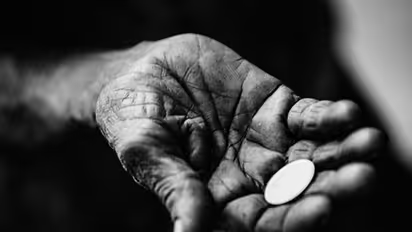India's poverty level may have fallen to around 5%: Niti Aayog CEO

Synopsis
A recent survey on household consumption expenditure has revealed significant shifts in spending patterns, with rural consumption showing resilience and narrowing the gap with urban areas. The data suggests a potential reduction in India's poverty levels
The most recent household consumption expenditure survey highlights a remarkable durability in rural spending, signalling a convergence with urban consumption trends. A Times of India report cited Niti Aayog's CEO, B V R Subrahmanyam as being buoyant about the results, hinting at a significant decrease in the country's poverty rates. "According to this data, poverty levels could be around 5% or even lower," stated Subrahmanyam, underscoring the near eradication of rural deprivation as indicated by the survey results.
Furthermore, the report highlighted the significance of this data in influencing the Reserve Bank of India's interest rate decisions, particularly noting the diminished share of food and cereals in the retail inflation index. The calculation of poverty levels hinges on consumption expenditure data, sparking intense debates over accurately estimating poverty rates. Notably, this survey provides the most recent insights since 2011-12, given the absence of data for 2017-18.
Analysis of the latest household consumption expenditure data reveals notable shifts in both rural and urban spending patterns. Notably, there has been a decrease in the proportion of expenditure allocated to food and cereals, coupled with a surge in spending on non-food items such as appliances, entertainment, healthcare, and transportation.
In rural areas, monthly per capita consumption spending witnessed a remarkable surge of 164%, reaching Rs 3,773 in 2022-23 from Rs 1,430 in 2011-12. Similarly, urban centers saw an increase of 146%, with expenditure reaching Rs 6,459 from Rs 2,630 during the same period. The survey indicates a decline in the share of food expenditure in both rural and urban areas, accompanied by a rise in non-food expenditure.
B V R Subrahmanyam, CEO of Niti Aayog, highlighted the evolving consumption trends, emphasizing the growing consumption of diverse food items such as beverages, processed foods, milk, and fruits. He noted that these changes would necessitate a recalibration of the consumer price index to accurately reflect retail inflation, particularly with the reduced contribution of food items.
The survey's findings also challenge previous poverty line estimations, notably those proposed by the panel led by ex-RBI governor C Rangarajan in 2014. Recent data suggests a significant departure from these estimations, with the average monthly consumption expenditure of the bottom 5-10% of the population surpassing the previously defined poverty thresholds.
"In light of the latest data, it's evident that poverty levels in India have substantially declined," remarked Soumya Kanti Ghosh, part-time member of the 16th Finance Commission and group chief economic adviser of SBI. Ghosh highlighted the discrepancy between the earlier poverty line definitions and the current consumption expenditure trends, indicating a shift towards lower poverty rates in the country.
Stay updated with the Breaking News Today and Latest News from across India and around the world. Get real-time updates, in-depth analysis, and comprehensive coverage of India News, World News, Indian Defence News, Kerala News, and Karnataka News. From politics to current affairs, follow every major story as it unfolds. Get real-time updates from IMD on major cities weather forecasts, including Rain alerts, Cyclone warnings, and temperature trends. Download the Asianet News Official App from the Android Play Store and iPhone App Store for accurate and timely news updates anytime, anywhere.